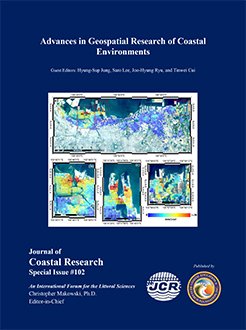Wu, M.; Zhao, Y.F.; Sun, L.E.; Huang, J.; Wang, X.H., and Ma, Y., 2020. Remote sensing of spatial-temporal variation of chlorophyll-a in the Jiaozhou Bay using 32 years Landsat data. In: Jung, H.-S.; Lee, S.; Ryu, J.-H., and Cui, T.W. (eds.), Advances in Geospatial Research of Coastal Environments. Journal of Coastal Research, Special Issue No. 102, pp. 271-279. Coconut Creek (Florida), ISSN 0749-0208.
The chlorophyll-a concentration (Chla, µg/L) is a vital indicator of water quality and eutrophication, yet optical complexity and significant variability of coastal waters make the accurate estimation of Chla challenging. Monitoring spatial-temporal distribution and variation of Chla and comprehending the correlation between Chla and environmental factors are necessary for long-term water quality assessment. This study calibrated and validated the Chla estimation model with satisfactory performance (R2, RMSE, and MRE values are 0.77, 0.64 µg/L, and 32.5 %) and further characterized the spatial-temporal variation of Chla in Jiaozhou Bay (JZB) based on 381 cloud-free Landsat images of 32 years (1986-2017). The annual mean Chla in JZB reached the highest value in 1997 and decreased gradually in the following two decades. The seasonal variation of Chla is obvious: the highest value of Chla appeared in summer, followed by spring, autumn and winter. Accordingly, the monthly averaged Chla peaked in July, while the minimum occurred in January. The spatial distribution of Chla on different time scales shared a similar pattern. High Chla appeared in the northwestern part of JZB and decreased gradually to the southwest, resulting in the lowest Chla near the water channel connected to the open sea. The spatial heterogeneity mainly arose from river discharge, while the temporal heterogeneity may be caused by seasonal variations in precipitation, temperature, and river discharge. This study indicated that the empirical models for the Landsat data could effectively monitor the long-term Chla variation in JZB.





